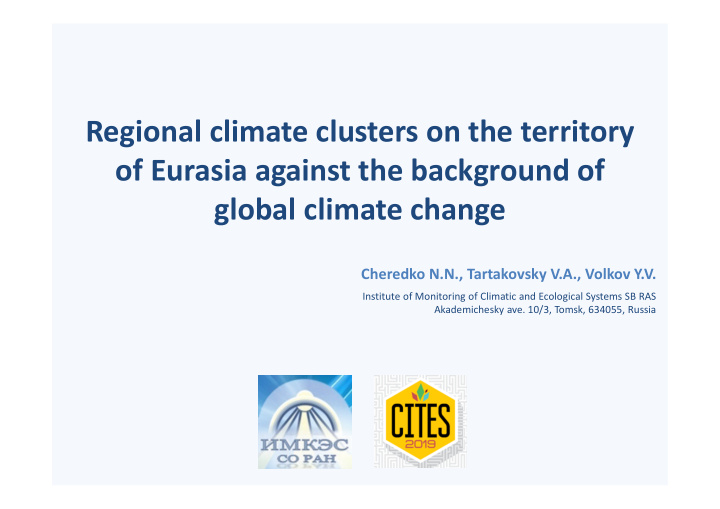



Regional climate clusters on the territory of Eurasia against the background of global climate change Cheredko N.N., Tartakovsky V.A., Volkov Y.V. Institute of Monitoring of Climatic and Ecological Systems SB RAS Akademichesky ave. 10/3, Tomsk, 634055, Russia
Возможности моделирования GOAL гидрометеорологических процессов ограничены недостатком знаний о системе , отсутствием « убедительной теории и подходящего ей математического аппарата » ( Дымников В.П. Устойчивость и предсказуемость крупномасштабных атмосферных процессов.2007 ) DETECTION OF PATTERNS OF TRANSFORMATION OF CLIMATE SYSTEM STRUCTURE ‼ Patterns of spatial-temporal changes in the components of the climate system is the basis of warning systems and adaptation to changing environmental conditions ‼ The topicality is stipulated by the growing importance of climate forecast quality improving. 2 CITES 2019 June Russia
THEORETICAL and EXPERIMENTAL DESIGN Indicators of energy exchange processes are the basis of climate classifications circulation of the heat cycle moisture cycle atmosphere Alisov's Genetic classifications of earth’s climate is based on the factors that determine the climate in a given place - on the spatial distribution and movement of the prevailing air masses. The most common in use, mainly in the post-Soviet states The Koppen climate classification is the most widely used system to catalog climate types in the world. Distribution of five base zones made by isotherms of the coldest and warmest months of the year ‼ Classical climatic classifications are an indicator of climate differences, not climate change 3 CITES 2019 June Russia
THEORETICAL and EXPERIMENTAL DESIGN ‼ As climate change becomes a reality, it’s becoming more necessary in different intervals of years to document and catalog climate types around the world The patterns of restructuring the fields of climate parameters can be detected by objectively solving the problem of climate classification in different periods of years taking into account the influence of external factors on the formation of regional climate clusters 4 CITES 2019 June Russia
THEORETICAL and EXPERIMENTAL DESIGN «… целью анализа многомерных временных рядов систем мониторинга CLIMATE CLUSTERS ARE FORMED ON THE BASIS предлагается считать поиск сигналов OF SYNCHRONIZED TEMPERATURE FLUCTUATIONS синхронизации , согласованности вариаций наблюдаемых параметров , измеряемых в пространственно разнесенных пунктах системы CLIMATIC CLUSTERS мониторинга или измеряемых в одном FORMATION ALGORITHM ( Любушин А.А. Анализ данных систем геофизического и пункте физически разных величин » экологического мониторинга. 2007 ) #1 AVERAGE MONTHLY MATRIX FORMATION Climate Change Indicators: #2 CALCULATION OF INITIAL PHASES Global Temperature #3 CALCULATION OF CORRELATION MATRIX OF PHASES #4 FORMATION OF CURRENT CLUSTERS #5 CALCULATION OF CURRENT PHASES #6 VERIFICATION Of CONVERGENCE : Y #7, N #3 #7 CALCULATION OF TYPE PHASES #8 CLUSTERS SEPARABILITY VERIFICATION #9 CLUSTERS CARD-SCHEME FORMATION The trend in global average temperature compared to a reference period of 1961–1990, as determined using three separate and independently analyzed sets of data. The grey shading indicates the uncertainty in the dataset from the Hadley Centre [ UK Met Office Hadley Centre via WMO ] 5 CITES 2019 June Russia
THEORETICAL and EXPERIMENTAL DESIGN NAO - main mode of variability at a seasonal time scale over the North Atlantic mid-latitudes 1976-2011 1955-1975 NAO values since 1824, using the WMO normal period 1951-1980 as base period [https://crudata.uea.ac.uk/cru/data/nao/viz.htm] CLIMATE CLUSTERS ARE FORMED ON THE BASIS OF SYNCHRONIZED TEMPERATURE FLUCTUATIONS AT 485 METEOROLOGICAL STATIONS IN EURASIA 6 CITES 2019 June Russia
RESULTS and CONCLUSION EURASIA TEMPERATURE FIELD CLASSIFICATION The value of the threshold correlation coefficient 0,8 Stations that are not included in any of the classes are marked with "+" Different station classes are indicated by different icons Areas where there have been changes in the structure fields are marked by ovals 12,2% 7 CITES 2019 June Russia
ALPINE STATIONS ARE MOST SENSITIVE RESULTS and CONCLUSION TO GLOBAL TEMPERATURE FLUCTUATIONS P N P 55 GW station country altitude Austria + C C Villacheralpe 2140 India + + C Mukteswar 2311 Switzerland + C C Saentis 2494 Austria + C C Sonnblick 3111 alpine weather station Sonnblick (3111 m) [https://www.sonnblick.net/de/das-observatorium/] 8 CITES 2019 June Russia
RESULTS and CONCLUSION The index of phase modulation for the normal period class error, % 40,77 39,46 57,28 20,72 32,72 45,21 33,94 55,12 9,45 55,49 15,40 9 CITES 2019 June Russia
CONCLUSION Significant changes in the structure of the consistency of temperature fluctuations in most parts of Eurasia are revealed. The use of only the surface temperature for the classification makes it possible to significantly simplify the dynamic analysis of the climate system structure transformation. 10 CITES 2019 June Russia
Thank you for your attention! CITES 2019 June Russia
Recommend
More recommend